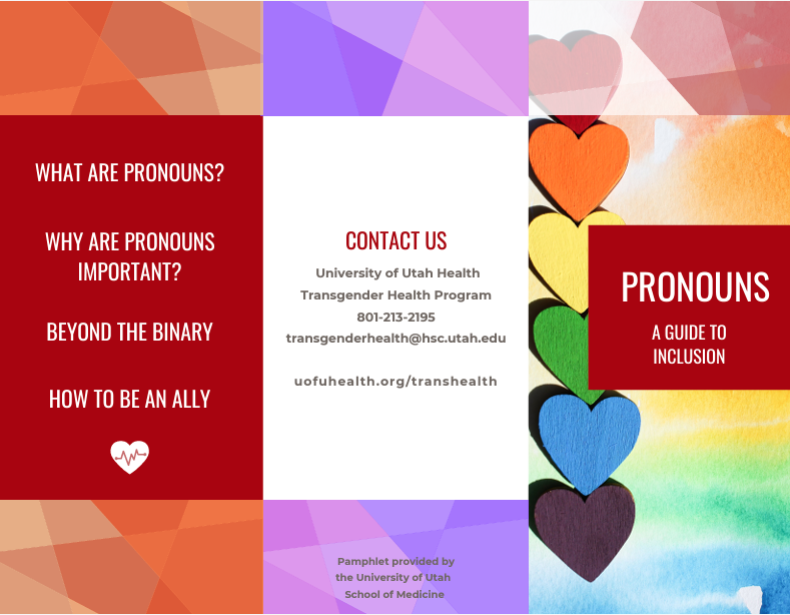Sheila’s experience
She kept calling me “Sonya.” I told her my name was Sheila at least two times. I started to avoid her when I saw her in the hallway of our shared building or in the parking lot. I didn’t feel comfortable with this person. She had significant authority, and it was awkward reminding her of my name again and again. I felt like she didn’t think I was important enough to remember my name.
Everybody deserves the dignity of being called by their chosen name and having their correct pronouns used. I can imagine how much more often I could be misnamed if my physical presentation didn’t “match” my name, or my pronouns didn’t match conventional ideas about gender. What would I do in medical appointments, where staff and providers can significantly impact my health outcomes? How many times would I correct someone before I just gave up? Before I just stopped seeking medical care because it wasn’t worth enduring disrespect?
Misgendering individuals causes harm
As someone with more than 10 years of experience working for the LGBTQ community, I (Clare) have many stories about the harm caused when an individual is not called by chosen name or correct pronouns. I have worked in 3 different LGBTQIA+ student resource centers in 3 different states, including the University of Utah LGBT Resource Center. I’ve worked with hundreds of trans, non-binary and gender diverse students and I’ve seen many cases of students who were misgenderedMisgendering occurs when you intentionally or unintentionally refer to a person, relate to a person, or use language to describe a person that doesn’t align with their affirmed gender. throughout their day.They got coffee; they were misgendered. They got on the bus; someone greeted them incorrectly as “sir” or “ma'am.” They attended class; they were misgendered by professors and classmates. Those microaggressions throughout the day take a toll, causing them to feel anxiety, self-doubt or have self-image issues. By creating environments where we normalize sharing pronouns and chosen names, we're hopefully limiting spaces where people are misgendered.
As a patient coordinator in the Transgender Health Program, I (Jess) also understand the importance of using correct names and pronouns with patients. Patients are in such a vulnerable position because of the intrinsic power imbalance built into health care systems. If this power is not respected by the gatekeepers of the care, it is disempowering to patients. I remember a specific experience where a patient was misgendered. They had just had bottom surgery and overheard the nurses calling them “it.”
By not using their pronouns, this person felt dehumanized.
Build Trust With Your Transgender Patients
Four transgender and gender diverse individuals share how powerful it is to be called by your name.
3 ways to build your practice of using chosen name and pronouns
All employees at the University of Utah are expected to use a patient’s chosen name (which may be different than their legal name) and their correct pronouns. Using correct names and pronouns demonstrates respect for patients. When patients have a respectful experience, they are more likely to continue the care they need.
Here are three recommendations for ensuring every individual feels the dignity of having their identity acknowledged:
Ask all patients what name and pronouns they like to use. This is probably the easiest way to get names right. You can help other employees use correct patient names by noting the chosen name in Epic.
Don’t assume gender identity based on physical appearance. This can relay a harmful message that people have to look or sound a certain way to demonstrate their gender. If you are unsure what pronouns to use, you can always refer to the individual by their first name.
Introduce yourself along with your pronouns. This invites others to feel comfortable sharing their pronouns.
As a white queer cisgender woman, people often correctly assume that I (Clare) go by she/her pronouns. But I’ve gotten into the habit of always introducing myself with my pronouns, just to draw more awareness. It can create more awareness to pay attention to pronouns before people are misgendered in the workplace or in other interactions.ns.
Getting into the habit of introducing yourself along with your pronouns, like any other habit, takes time to solidify. If you make an effort to share this information, initially you may do it in 20 percent of introductions. If you continue to make this a priority it will build to 30 percent, then 60 percent, and eventually become ingrained in the way you introduce yourself.
Own your mistakes
If you misname or misgender someone, correct yourself. Say “excuse me,” and use the right name or pronouns. If the moment has passed or you feel like it would be awkward to correct yourself, send a note over email or text such as, “Hey, I realized in the meeting, I called you by the wrong pronouns. So sorry about that. I'll do better in the future.”
Acknowledging you made a mistake and apologizing helps you to move on and do better next time.
Bystanders can also aid in the moment. If you are someone who witnesses misnaming or misgendering, a good way to do a gentle correction is to follow up by using the person's pronouns or correct name in conversation. It's subtle but it's heard.
Everyone has the right to be called by the right name, to have their name pronounced correctly, and to be called by the right pronouns. We're all here to serve patients and to provide respectful, medically accurate care. Pronoun usage is just one of the many ways that we can help empower our patients to take charge of their health, by showing we are partners in their health.
Sheila Sconiers
Clare Lemke
Jessica Stahle
Transgender and gender diverse patients face systemic discrimination in our broader society and inequitable access to needed care. Ariel Malan, program coordinator and Andy Rivera, volunteer for Utah’s Transgender Health Program, share how to create an inclusive care environment for this vulnerable population focused on trust and respect.
U of U Health recently received the LGBTQ Health Care Equality Top Performer designation from the Human Rights Campaign Foundation—but this achievement didn’t happen overnight. Plastic surgeon and Transgender Health Program Director Cori Agarwal, and Program Coordinator Ariel Malan, share the grit, determination and patient collaboration that transformed our health care system.
Understanding a patient’s sexual orientation and gender identity (SOGI) is necessary to provide quality, consistent and compassionate care to all of our patients. Gastroenterologist and Chair of the Department of Internal Medicine John Inadomi explains why a focus on SOGI is needed.

